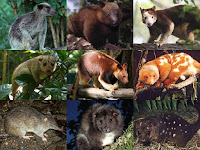Today I finally start my new blog series titled Following folktales around the world! If you would like to know what the series is all about, you can find the introduction post here. You can find all posts under the Following Folktales label.
One Thousand and One Papua New Guinean Nights
Folktales from Wantok Newspapers
Thomas H. Slone
Masalai Press, 2001.
I have got to come clean and admit that I only read the first of two volumes. The two of them together contain 1001 folktales, myths, and legends; I read 602 of them. The volume was 500 pages with two columns on each page, and heavy enough to leave marks on my sternum when I read it in bed... it was hard work to get through it, but absolutely worth it.
The author tells us that all these stories were published over the years in Wantok newspaper in the creole language of Papua New Guinea known as Tok Pisin. If each tale had to be translated from its original language, this book would never have been born - the island sports a stunning number of about 700 different languages (!).
 |
| Showing my work |
The stories themselves reflect the local flora, fauna, and traditional way of life. They are full of elements that seem exotic to the Western reader - instead of wolves or swan, we have cassowaries and marsupials in great abundance. Nature is both terrifying and helpful, depending on how one interacts with it, and inhabited by spirit creatures known as masalai that can be evil or benevolent. Many stories are bloody and violent, but there are also several that are enchanting and all kinds of beautiful.
Highlights
There were many of these. I marked each one with a sticky note, and ended up with more than 50 of them. It is not a bad number at all for any folktale collection.
I especially liked tales where Nature helped or rescued someone. There was a Cinderella-type story where a girl told her sorrows to a mango tree; the three then was turned into a canoe and took her to live with kinder people. One of my favorite stories was the one where a woman was stalked and killed by an evil man; the cassowaries brought her back to life, and then kicked the tar out of the murdered. As a reward, the woman painted the kind birds bright colors (and in some versions she turned into a pandanus tree to feed them). In another great story a giant masalai clam kept swallowing ships, until a smart cassowary tricked it into coming to land, where the vines of the jungle and the red ants finished it off. There were multiple tales where a woman, left alone by her husband, gave birth in the woods and was helped by kind masalai women. In another legend a heroic little flying fox saved his (human) mother and little brother from a terrible giant serpent. I also found several stories about loyal and helpful dogs.
Of course the volume was teeming with pourquoi stories, explaining how certain things came to be. In one, a kind old woman kept all the mosquitoes in the world locked up in her house... until wicked children stole bananas from her, and she let them out as revenge. In another, funny story, we learned how men stole beards from women, because they envied their spouses' luxurious facial hair. There was a story that explained how a hunter used to keep the Moon in a bamboo tube, and use it as a flashlight, until it finally escaped and rose up to the sky. Another, more terrifying tale recounted how the Moon used to come down from the sky and devour children, until the people of a village killed it and cut it into pieces, replacing it with a friendlier Moon...
Some stories had practical elements, such as origin tales of stone axes, firemaking, or why pottery shards can be found in the ground. Others, labeled "modern stories", told about the encounters of the indigenous people with Western technology (such as radios, flashlights, soap, or airplanes), and the funny moments that resulted from them.
Connections
 |
| Marsupials from PNG (picture from here) |
I found a version of the "Why dogs sniff each other's tails" folktale that I have known before as a Cherokee story. It tells about how dogs used to play soccer and volleyball, hanging their cumbersome tails on a fence, until a pig tore the fence down and the tails got mixed up... I also found versions of the shape-changing bride (see Thetis in Greek mythology), the loyal dog (see Gelert the Faithful Hound), and the money tree (see Rübezahl's crab-apples). There was a tale about a cucumber that turned into an evil woman who forced a man to carry her around on his shoulders - this reminded me of Sindbad the Sailor and his adventure with the Old Man of the Sea. There was even a "grateful snake" story where a hunter saved a little snake stuck in a snail shell, and the snake later returned to pull a broken lance out of the man's side after a battle.
I found "closer" connections to a folktale from the Maldives (the Heron and the Crab), and a story from Borneo, in which a mysterious old woman in the forest has snakes and lizards in her hair instead of lice (which the protagonist has to pick out to earn her help).
Where to?
Moving on to the Federated States of Micronesia! Stay tuned!


I really love hearing about all these stories. They always give me ideas!
ReplyDelete